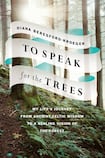
Born to an aristocratic Anglo-Irish father, John Lisle de la Paor Beresford, and with her mother descended from the high kings of Ireland, Diana Beresford Kroeger had a tough start. Her mother a cold beauty who made sure her child knew she was never more than “a nuisance”, and shouted triumphantly when the dad was killed, “Jack, the bastard, is dead!”, was killed in a car crash a few months later herself. When the traumatised 11 year old was brought before the judge in Cork, he asked: “What will I do with you?” There were two options: the nearby Magdalene Laundry in Sundays Well – “nightmarish hotbeds of abuse and death” – or back to her mother’s Georgian house in town and bachelor Uncle Pat. (The Beresfords, being aristocrats, had no time for a girl.) By a miracle, the judge allowed the child to be sent back to the non-existent care of the bachelor uncle, oblivious to a body’s even basic needs, and “staff”.
A summer vacation to her mother’s people in Lisheen was her salvation; a rocky enclave in west Cork where, thanks to its remoteness, the Brehon/Gaelic ways had survived Britain’s brutal 500-year occupation, its Penal Laws smashing “old” Ireland to its knees, she was welcomed, fed and taught self-care. Under Brehon law an orphan was the community’s responsibility and the old people inducted her into Nature’s secrets, the wisdoms of the past. Starving for food, love and knowledge the “Gidl”, or cailín, was nourished on every level.
When she returned to the city “a mantle” of love came with her. Miraculously she discovered the bachelor uncle’s 10,000-book library and how to boil potatoes. Her “brainbox” status at school brought followers, if not initially friends: “Go ask Diane”. Acing all her exams, the nuns brought in a special maths tutor just for her. She hit University College Cork, took medical biochemistry and “vigorously busted out of her shell” joining athletics, rowing and tennis clubs, her parents’ sudden deaths convincing her “never to waste a second”.
Observational skills
She bought a Mini with the last of her inheritance, squandered by a foolish lawyer, and one evening driving to Kinsale with half the rugby team on board was stopped by the gardaí who ordered everyone out. So astonished at the volume of male bulk emerging, the garda said if she could get them all back in he wouldn’t give her a ticket. She did. And he didn’t. All this while continuing to get firsts, teaching one of her lecturer’s courses as he fell ill, making important scientific observations and discoveries, and painting which helped develop her observational skills, a yellow paint box being the only present her mother gave her.
Research opportunities for graduates, even brilliant ones, were limited in 1970s Ireland; for females they were non-existent. She headed to America, which she didn’t like, then to Canada, which she did, specialising in nuclear chemistry and advanced organic chemistry. Working at the Canadian Experimental Farm she discovered bioluminescence but when she applied to stay on the board said no. She was a woman. She should marry, have babies. Her head of department, incandescent with fury at this misogyny, smashed the fire axe off the wall and hacked up the lab’s parquet floor. “The bastards. If they won’t pay for you, they’ll pay for this floor.” Hurray for him.
It was sexism within academia, having her work stolen by men, and sniffy attitudes to her Celtic knowledge – “ science and the sacred do not mix” that decided her to go it alone, along with her now soul mate, Christian. They bought a plot of land near Ottawa, built a house, living in a shack as they did so, and created a garden and arboretum as near to “old” Nature as possible: her “bioplan”. Her man, whose father was responsible for astronauts’ safety, said those who see the Earth from space come back believing “the Earth is a fragile closed system, if we don’t treat it right it will get rid of us”.
Climate change
Her life’s work has been to advocate for Mother Earth, especially the great forests of the world – for all life’s connectedness. Her arboretum now houses the greatest collection of native species of North America. A passionate activist – “You’ve got to stay on your hind legs and take a swing” – she believes if everyone on the planet planted six trees over the next six years we could halt climate change; literally give ourselves time to breathe.
If tree culture here hadn’t been taken over by the gombeen men and their faux “forests” of miserable Sitka spruce doused with pesticides and clamped inside barbed wire enclosures, Ireland could be an exemplar to the world, replanting the great native forests of old, home to 60 per cent of the world’s known medicines, and goddamit our lungs. Sadly the gombeen men are still riding high worldwide.
Put simply, says Diana Beresford-Kroeger, if we continue to obliterate the great forests we will soon all suffocate.
The last 90 pages of this extraordinary book are devoted to Ogham the ancient script of the Celts, second-oldest written language in the world, based entirely on trees.












